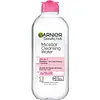Garnier Micellar Cleansing Water All-In-1 Versus TONYMOLY Wonder Ceramide Mochi Gentle Foam Cleanser
What's inside
What's inside
 Key Ingredients
Key Ingredients

No key ingredients
 Benefits
Benefits

 Concerns
Concerns

No concerns
 Ingredients Side-by-side
Ingredients Side-by-side

Water
Skin ConditioningGlycerin
HumectantDisodium Laureth Sulfosuccinate
CleansingButylene Glycol
HumectantCocamidopropyl Betaine
CleansingCoco-Glucoside
CleansingDipropylene Glycol
HumectantOlea Europaea Fruit Oil
MaskingOlive Oil Glycereth-8 Esters
EmollientSodium Chloride
MaskingCitric Acid
BufferingPanthenol
Skin ConditioningHydroxyacetophenone
Antioxidant2,3-Butanediol
HumectantEthylhexylglycerin
Skin ConditioningDisodium EDTA
Caprylic/Capric Triglyceride
MaskingSucrose Palmitate
Emollient1,2-Hexanediol
Skin ConditioningHydrogenated Lecithin
EmulsifyingCeramide NP
Skin ConditioningNiacinamide
SmoothingCucumis Sativus Fruit Extract
EmollientAloe Barbadensis Leaf Extract
EmollientHydrogenated Phosphatidylcholine
EmulsifyingSucrose Stearate
EmollientSoluble Collagen
HumectantCentella Asiatica Extract
CleansingCetearyl Alcohol
EmollientAsiatic Acid
Skin ConditioningAsiaticoside
AntioxidantMadecassic Acid
Skin ConditioningMadecassoside
AntioxidantCitrus Limon Peel Oil
MaskingParfum
MaskingLimonene
PerfumingLinalool
PerfumingWater, Glycerin, Disodium Laureth Sulfosuccinate, Butylene Glycol, Cocamidopropyl Betaine, Coco-Glucoside, Dipropylene Glycol, Olea Europaea Fruit Oil, Olive Oil Glycereth-8 Esters, Sodium Chloride, Citric Acid, Panthenol, Hydroxyacetophenone, 2,3-Butanediol, Ethylhexylglycerin, Disodium EDTA, Caprylic/Capric Triglyceride, Sucrose Palmitate, 1,2-Hexanediol, Hydrogenated Lecithin, Ceramide NP, Niacinamide, Cucumis Sativus Fruit Extract, Aloe Barbadensis Leaf Extract, Hydrogenated Phosphatidylcholine, Sucrose Stearate, Soluble Collagen, Centella Asiatica Extract, Cetearyl Alcohol, Asiatic Acid, Asiaticoside, Madecassic Acid, Madecassoside, Citrus Limon Peel Oil, Parfum, Limonene, Linalool
 Reviews
Reviews

Ingredients Explained
These ingredients are found in both products.
Ingredients higher up in an ingredient list are typically present in a larger amount.
Disodium EDTA plays a role in making products more stable by aiding other preservatives.
It is a chelating agent, meaning it neutralizes metal ions that may be found in a product.
Disodium EDTA is a salt of edetic acid and is found to be safe in cosmetic ingredients.
Learn more about Disodium EDTAGlycerin is already naturally found in your skin. It helps moisturize and protect your skin.
A study from 2016 found glycerin to be more effective as a humectant than AHAs and hyaluronic acid.
As a humectant, it helps the skin stay hydrated by pulling moisture to your skin. The low molecular weight of glycerin allows it to pull moisture into the deeper layers of your skin.
Hydrated skin improves your skin barrier; Your skin barrier helps protect against irritants and bacteria.
Glycerin has also been found to have antimicrobial and antiviral properties. Due to these properties, glycerin is often used in wound and burn treatments.
In cosmetics, glycerin is usually derived from plants such as soybean or palm. However, it can also be sourced from animals, such as tallow or animal fat.
This ingredient is organic, colorless, odorless, and non-toxic.
Glycerin is the name for this ingredient in American English. British English uses Glycerol/Glycerine.
Learn more about GlycerinWater. It's the most common cosmetic ingredient of all. You'll usually see it at the top of ingredient lists, meaning that it makes up the largest part of the product.
So why is it so popular? Water most often acts as a solvent - this means that it helps dissolve other ingredients into the formulation.
You'll also recognize water as that liquid we all need to stay alive. If you see this, drink a glass of water. Stay hydrated!
Learn more about Water